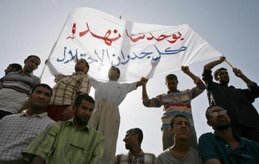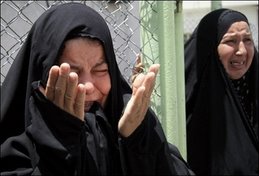احتجاز الولايات المتحدة للأطفال دون مراعاة إجراءات التقاضي السليمة
تقرير هيومن رايتس ووتش
قالت هيومن رايتس ووتش اليوم إنه ينبغي على القوات الأميركية في العراق أن تعمل على مراعاة معاملة الأطفال الخاضعين للاحتجاز على النحو المتفق مع وضعهم كأطفال، وإحالتهم للمراجعة القضائية الفورية وتمكين المراقبين المستقلين من مقابلتهم. ومن المقرر أن تنعقد لجنة الأمم المتحدة لحقوق الطفل في 22 مايو/أيار في جنيف لمراجعة التزام الولايات المتحدة بالاتفاقية الدولية لحظر استخدام الأطفال كجنود، والتي تُلزم الدول بالمساعدة على تعافي مثل هؤلاء الأطفال – التابعين للدول الأطراف – وإعادة دمجهم في المجتمع.
وكانت السلطات العسكرية الأميركية – التي تعمل ضمن القوات متعددة الجنسيات في العراق – وحتى 12 مايو/أيار 2008، تحتجز 513 طفلاً باعتبارهم "تهديداً للأمن"، وقامت بنقل عدد مجهول من الأطفال الآخرين إلى الاحتجاز لدى السلطات العراقية. وطبقاً لتقرير صدر مؤخراً عن بعثة الأمم المتحدة لمساعدة العراق (يونامي)، فإن الأطفال رهن الاحتجاز العراقي يتعرضون لخطر الإساءات البدنية. وقالت كلاريسا بينكومو، باحثة حقوق الطفل في منطقة الشرق الأوسط وشمال أفريقيا في هيومن رايتس ووتش: "كانت الولايات المتحدة صاحبة دور قيادي في مساعدة الجنود الأطفال على العودة إلى المجتمع، وهذا في النزاعات التي ليست طرفاً مباشراً فيها، ". وأضافت: "لكن للأسف لا يتم الاضطلاع بهذا الدور القيادي في العراق".
ومن المقرر أن تنعقد لجنة الأمم المتحدة لحقوق الطفل في 22 مايو/أيار في جنيف لمراجعة التزام الولايات المتحدة بالبروتوكول الاختياري بشأن الأطفال المتورطين في النزاعات المسلحة، والذي صدقت عليه الولايات المتحدة في عام 2002. وتحظر الاتفاقية تجنيد واستخدام الأطفال تحت سن 18 عاماً في النزاعات المسلحة من جانب أي من الأطراف في النزاع، وتطالب الدول بتوفير كل المساعدة المُستطاعة من أجل تعافي مثل هؤلاء الأطفال – التابعين للدول الأطراف أو الواقعين ضمن نطاق سلطتها – بدنياً ونفسياً وإعادة دمجهم في المجتمع. وقد احتجزت الولايات المتحدة منذ عام 2003 زهاء 2400 طفل في العراق، بمن فيهم أطفال يبلغ عمرهم 10 أعوام. وقد تزايدت معدلات الاحتجاز إلى حد كبير في عام 2007 لتصل إلى ما يُقدر في المتوسط بمائة طفل شهرياً، بعد أن كان المتوسط هو 25 طفلاً في الشهر خلال عام 2006. وتحتجز الولايات المتحدة غالبية الأطفال في مخيم كروبر ببغداد، لكنها تحتجز أيضاً بعض الأطفال في مركز الاحتجاز الأميركي الأساسي، مخيم بوكا القريب من البصرة. وقال مسؤولون أميركيون في وقت سابق من هذا العام لـ هيومن رايتس ووتش إنهم يفصلون بين الأطفال والمحتجزين البالغين في مراكز الاحتجاز هذه، لكن لا يفصلون بين الأطفال من ذوي الأعمار الأقل، أو الأطفال المعرضين للضرر بشكل خاص، وبين الأطفال المحتجزين الآخرين. وتناقلت التقارير في مطلع عام 2007 أن صبياً يبلغ من العمر 17 عاماً قد مات مختنقاً على يد مُحتجز طفل آخر في مخيم كروبر. ويمكن أن يتعرض الأطفال المحتجزين – ودون اختلاف عمّا يحدث للبالغين – للاستجواب على مدار أيام أو أسابيع على يد الوحدات العسكرية المتواجدة ميدانياً، قبل نقلهم إلى مراكز الاحتجاز الأساسية. ولا يحظون بفرصة حقيقية للطعن في احتجازهم. وفي وقت سابق من هذا العام قال مسؤولون أميركيون لـ هيومن رايتس ووتش إن الأطفال لا يقابلون محامين أو يحضرون جلسات مراجعة أسبوعية أو شهرية لاحتجازهم بعد نقلهم إلى مخيم كروبر. فضلاً عن أن اتصال الأطفال بأسرهم جد محدود. وفيما تمنح الولايات المتحدة لكل طفل "محام" عسكري أثناء مراجعة الاحتجاز بعد مرور ستة أشهر، فهذا المحامي لم يتلق تدريباً على عدالة الأحداث أو نمو الأطفال.
وحتى فبراير/شباط 2008 كان متوسط فترة احتجاز الأطفال المعروف هو 130 يوماً، وبعض الأطفال يتم احتجازهم لأكثر من عام دون إخلاء سبيلهم أو مثولهم أمام المحكمة، وهذا في انتهاك لمذكرة سلطة الائتلاف المؤقتة الخاصة بالإجراءات الجنائية. وقد ورد في الجزء بعنوان "إجراءات احتجاز المحتجزين الأمنيين" من المذكرة: "أي شخص دون الثامنة عشرة، يحتجز في أي وقت، يجب الإفراج عنه في كل الحالات في فترة لا تتعدى 12 شهراً من تاريخ إدخاله مرفق الاعتقال". وقالت كلاريسا بينكومو: "الغالبية العظمى من الأطفال المحتجزين في العراق يشقون لشهور رهن الاحتجاز الأميركي". وأضافت: "وعلى الولايات المتحدة أن توفر لهؤلاء الأطفال على الفور محامين ومراجعة قضائية مستقلة لوضعهم في الاحتجاز". وفي أغسطس/آب 2007 فتحت الولايات المتحدة دار الحكمة في مخيم كروبر وكانت النية المُعلنة هي توفير خدمات تعليمية لستمائة مُحتجز تتراوح أعمارهم بين 11 و17 عاماً، وهذا حتى إخلاء سبيلهم أو نقلهم للاحتجاز لدى السلطات العراقية. إلا أنه في مايو/أيار 2008 قال مسؤولون عسكريون أميركيون في بغداد لـ هيومن رايتس ووتش إن 200 إلى 300 طفل فقط من الأطفال البالغ عددهم 513 المحتجزين قد التحقوا بصفوف دراسية في دار الحكمة. وفي الوقت الراهن فإن الأطفال المُستبعدين من البرنامج لا يتلقون أي تعليم. وكحال البالغين، فإن الأطفال المنقولين إلى الاحتجاز لدى الطرف العراقي يتعرضون لخطر الإساءات وسوء الأوضاع الخاصة بالاحتجاز. وقال مسؤول عسكري أميركي في بغداد لـ هيومن رايتس ووتش هذا الشهر إن الولايات المتحدة قد قامت بتأخير
نقل 130 طفلاً إلى الطرف العراقي في مركز احتجاز الطوبشي للأحداث بسبب تدهور الأوضاع في ذلك المركز.
وقد خلصت بعثة الأمم المتحدة لمساعدة العراق (يونامي) إلى أن ازدحام مركز الطوبشي يؤدي إلى مشكلات صحية، وهذا أثناء زيارات قامت بها البعثة في أكتوبر/تشرين الأول ونوفمبر/تشرين الثاني 2007. وفي ذلك الحين كان المركز يضم ضعف سعته الطبيعية تقريباً، وهي 200 سرير، وكان الأطفال يتشاركون في الأسرة أو يتناوبون في النوم على الأرض دون أي فراش تحتهم. وحتى الآن لم تُصدر الولايات المتحدة إحصاءات عن أعداد الأطفال الذين قامت بنقلهم إلى الاحتجاز لدى الطرف العراقي لغرض المُحاكمة. وطبقاً لـ يونامي، فإن 89 طفلاً قد تم نقلهم من الاحتجاز الأميركي إلى العراقي وتمت إدانتهم بجرائم، وهذا حتى ديسمبر/كانون الأول 2007. وبين ديسمبر/كانون الأول 2007 ومارس/آذار 2008، تراجع عدد الأطفال المحتجزين لدى الطرف الأميركي ليصبح 450 طفلاً، لكن الولايات المتحدة لم تُعلن عما إذا كانت قد أفرجت عنهم أو نقلتهم إلى الاحتجاز لدى السلطات العراقية. وتدعو هيومن رايتس ووتش القوات العسكرية الأميركية في العراق إلى
ضمان أن الأطفال الخاضعين للاحتجاز طرفها يلقون مساعدة قانونية مستقلة على وجه السرعة وكذلك زيارات من الأقارب
: خلفية
منذ إعلان انتهاء الاحتلال الأميركي للعراق في يونيو/حزيران 2004، أصبح من اللازم أن يلقى الأشخاص المحتجزين إجراءات التقاضي السليمة بموجب القانون الدولي لحقوق الإنسان. ويسمح قرار مجلس الأمن 1546 والقرارات التالية عليه باحتجاز العراقيين "لأسباب أمنية". إلا أن الولايات المتحدة تستخدم هذه الصيغة على نحو غير سليم في تبرير احتجازها للأشخاص دون مراجعة قضائية، مجردين من حقوق أساسية أخرى، وكأن القانون المُطبق هو اتفاقية جنيف الرابعة بشأن معاملة المدنيين أثناء النزاعات الدولية المسلحة. بينما يتطلب قانون حقوق الإنسان – كما ورد في العهد الدولي الخاص بالحقوق المدنية والسياسية – أن يمثل جميع الأشخاص المحتجزين على الفور أمام قاض، وأن يقابلوا دفاعاً يمثلهم وكذلك أفراد الأسرة، وأن تُنسب إليهم اتهامات بارتكاب مخالفات جنائية يمكن محاكمتهم على ارتكابها، وأن يحصلوا على محاكمات سريعة تتفق مع المعايير الدولية للمحاكمة العادلة. كما يجب على جميع الدول بموجب العهد أن تتخذ بالنسبة لكل طفل "تدابير الحماية التي يقتضيها كونه قاصراً". وبموجب معايير عدالة الأحداث الدولية، فإن الأطفال المتهمين بجرائم يجب أن تتم محاكمتهم في نظام عدالة أحداث متخصص، على أيدي قضاة ومدعين عموميين ومحامين مدربين، ويعملون في إطار العدالة الإصلاحية والتأهيل الاجتماعي. واعتقال واحتجاز الطفل يجب ألا يُستخدم إلا كإجراء أخير بعد استنفاد كل الخيارات الأخرى، ولأقصر فترة زمنية ممكنة. ويجب أن يتم فصل الأطفال المحتجزين عن البالغين، وأن يقابلوا الدفاع على الفور وأي من أشكال المساعدة على ال
طعن في الاحتجاز
Children in US Custody Held Without Due Process.
(hrw.org Geneva, May 21, 2008) – US forces in Iraq should ensure that children it takes into custody are treated according to their status as children, and given prompt judicial review and access to independent monitors, Human Rights Watch said today. On May 22, the UN Committee on the Rights of the Child will meet in Geneva to review US compliance with the international treaty banning the use of child soldiers, which requires states to help with the recovery and reintegration of such children under their control.
US military authorities, operating as the Multinational Forces in Iraq, were as of May 12, 2008 holding 513 Iraqi children as “imperative threats to security,” and have transferred an unknown number of other children to Iraqi custody. According to a recent report by the United Nations Assistance Mission in Iraq (UNAMI), children in Iraqi custody are at risk of physical abuse. “In conflicts where it was not directly involved, the US has been a leader in helping child soldiers re-enter society,” said Clarisa Bencomo, Middle East children’s researcher at Human Rights Watch. “That kind of leadership is unfortunately missing in Iraq.” On May 22, the UN Committee on the
In early 2007, a 17-year-old boy was reportedly strangled to death by a fellow child detainee at Camp Cropper.
• Ensure children in its custody receive prompt access to independent legal assistance and
family visits;
• Provide children with prompt review of detention by an independent judicial body;
• Release children who have been detained for more than a year, in compliance with Section 6,
Article 5 of Coalition Provisional Authority Memo 3 (revised) of June 27, 2004;
• Separate very young and other particularly vulnerable children from other detainees;
• Allow UNICEF, UNAMI, and other independent monitors confidential access to children in US
custody;
• Refrain from transferring physical custody of children to Iraqi authorities pending trial when
there is reason to believe they will be at risk of abuse; and,
• Ensure the right to education and recreation of all children in US custody.
Since the declared end of the US occupation of Iraq in June 2004, detained persons should be provided due process under international human rights law. Security Council Resolution 1546 and its successors allow for internment of Iraqis “for imperative reasons of security.” However, the United States improperly uses this language to justify holding the detainees without judicial review and other basic rights, as if the operative law were the Fourth Geneva Convention on the treatment of civilians during international armed conflict. Human rights law, as found in the International Covenant on Civil and Political Rights, requires that all persons arrested be brought promptly before a judge, have access to legal counsel and family members, be charged with a cognizable criminal offense, and receive a prompt trial meeting international fair trial standards. It also requires states to provide every child “such measures of protection as are required by his status as a minor.”









